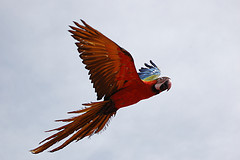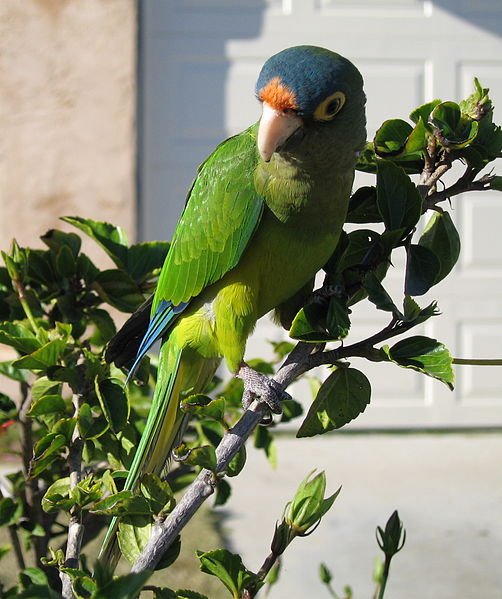The following blog entry was done by a guest blogger and does not necessarily reflect the views of That Fish Place/That Pet Place. Please welcome Dave Womach, Professional Parrot Trainer at Birdtricks.com![]()
When you first hear the term, “freeflight parrot” you might expect to see a parrot flying through hoops in bird show at a theme park, or perhaps doing some stunt in a washed up Vegas showroom in a dingy hotel located in the wrong part of town, just north of the famous strip. Very few people are fully aware of the “no-limits” potential of what I refer to as, Freestyle Flying™.
 Imagine for a moment what it would be like, if you took your clipped parrot outside, let go of his feet and a 25 mph wind gust took him out of your hands never to see him again. For many, that is unfortunately a very common story.
Imagine for a moment what it would be like, if you took your clipped parrot outside, let go of his feet and a 25 mph wind gust took him out of your hands never to see him again. For many, that is unfortunately a very common story.
Now imagine going to some exotic location after 90 days of formal training and intentionally letting go of your parrot. Nothing beats the rush of a gust of wind taking your parrot 50 feet up into the air, as you watch that bird maneuver on an invisible wave of wind, as if he were a surfer riding on the great waves of Hawaii. He skillfully hovers in one spot until he gets enough confidence to surf the air and coast back and forth, only to land on your hand a couple of minutes later.
 Freestyle Flying™ isn’t for everyone, but it is for every bird. And if you’re the kind of person who is willing to put in a lot of time, energy, and research, this can be the best quality of life that you can offer your parrot.
Freestyle Flying™ isn’t for everyone, but it is for every bird. And if you’re the kind of person who is willing to put in a lot of time, energy, and research, this can be the best quality of life that you can offer your parrot.
Over the past year I have been fortunate enough to fly my flock at locations all across the U.S., and watch as they go from freshly weaned baby parrots, to fully skilled pro’s.
My favorite thing to watch them do, is a term called Jinking. (v. jinked, jink•ing, jinks
 To make a quick, evasive turn) As your parrots become more and more confident and skilled, they’ll start to experiment with evasive maneuvers that they use in the wild to evade predators such as hawks and eagles. They’ll actually flip upside down, flap, turn right side up, upside down, etc until they have successfully evaded the predator. Although I have seen this used twice to actually evade a hawk (or flock of seagulls), they also love just practicing it on their own.
To make a quick, evasive turn) As your parrots become more and more confident and skilled, they’ll start to experiment with evasive maneuvers that they use in the wild to evade predators such as hawks and eagles. They’ll actually flip upside down, flap, turn right side up, upside down, etc until they have successfully evaded the predator. Although I have seen this used twice to actually evade a hawk (or flock of seagulls), they also love just practicing it on their own.
If you ever have the opportunity to experience the freedom of flight, through Freestyle Flying™, make sure that you don’t miss out on the opportunity.
To see a brief video that will wet your appetite, click here: http://www.youtube.com/watch?v=O7CZsTiPiXw
 That Bird Blog – Bird Care and History for Pet Birds
That Bird Blog – Bird Care and History for Pet Birds

 People have mixed feelings about teaching budgerigars, macaws, cockatoos and other parrots to perform tricks. Some claim that such is somehow “degrading” (to the bird, I assume!) while others consider training to be vital in forging a good relationship with one’s pet. My experience with captive animals of all types has convinced me that, when properly carried out, trick training greatly improves the quality of life for parrots and other highly intelligent creatures.
People have mixed feelings about teaching budgerigars, macaws, cockatoos and other parrots to perform tricks. Some claim that such is somehow “degrading” (to the bird, I assume!) while others consider training to be vital in forging a good relationship with one’s pet. My experience with captive animals of all types has convinced me that, when properly carried out, trick training greatly improves the quality of life for parrots and other highly intelligent creatures. If your interests include both pet bird keeping and the conservation of wild birds, you may wish to consider becoming involved in a local bird-banding program. My own first crude attempts at this fascinating endeavor involved trapping birds as a child with an old-fashioned “stick-holding-up-a-box-trap”, and really took off when, courtesy of my naturalist grandfather, I acquired a professional Havahart Live Animal Trap.
If your interests include both pet bird keeping and the conservation of wild birds, you may wish to consider becoming involved in a local bird-banding program. My own first crude attempts at this fascinating endeavor involved trapping birds as a child with an old-fashioned “stick-holding-up-a-box-trap”, and really took off when, courtesy of my naturalist grandfather, I acquired a professional Havahart Live Animal Trap. Last time we took a look at the unusual nesting behavior of this popular little parrot (please see The Half Moon, Orange-Fronted or Petz’s Conure and its Relationship with the Arboreal Black-Headed Termite.) But, as if breeding in termite mounds were not enough to distinguish it from other parrots, the half moon conure also changes the usual parrot “roosting rules” as well. And with good reason…
Last time we took a look at the unusual nesting behavior of this popular little parrot (please see The Half Moon, Orange-Fronted or Petz’s Conure and its Relationship with the Arboreal Black-Headed Termite.) But, as if breeding in termite mounds were not enough to distinguish it from other parrots, the half moon conure also changes the usual parrot “roosting rules” as well. And with good reason…